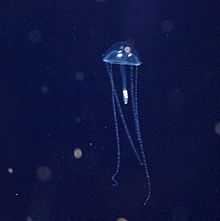| Liriope tetraphylla | |
|---|---|

| |
| Liriope tetraphylla | |
| Scientific classification | |
| Domain: | Eukaryota |
| Kingdom: | Animalia |
| Phylum: | Cnidaria |
| Class: | Hydrozoa |
| Order: | Trachymedusae |
| Family: | Geryoniidae |
| Genus: | Liriope Lesson, 1843 |
| Species: | L. tetraphylla |
| Binomial name | |
| Liriope tetraphylla (Chamisso & Eysenhardt, 1821) | |
| Synonyms | |
| |
Liriope is a genus of hydrozoan in the family Geryoniidae. It contains only one species, Liriope tetraphylla.
Description
Liriope tetraphylla has marginal tentacles, a manubrium, and gonads that are all green or rose-red in colour. It has a nearly hemispherical umbrella which is normally 10 to 30 mm wide. The exumbrella has four interradial and four perradial nematocyst tracks that are short in length. It has a well-developed velum. Normally, there are four radial canals that are straight. The ring canal is broad, and each quadrant has 1 to 3 (and possibly more) centriipedal canals that are short and blind. A marginal nematocyst ring is present. It has thick jelly, particularly in the region towards the apex.
The manubrium of Liriope tetraphylla are extend from a long, gastric pendicule. These manubrium are normally 1 to 3 times the height of the umbrella. There are four lips on the mouth that are either simple or slightly crenulated. The subumbrellar part of the radial canals have four gonads that are leaf-shaped and flattened. These gonads may vary greatly in size and shape.
This species has eight ecto-endodermal statocysts that are enclosed within mesogloea. There are four perradial marginal tentacles that are hollow and long and have nematocyst rings. There are also four interradial tentacles that are small and solid. these have adaxial nematocyst clusters.
Polyp stage
Liriope tetraphylla does not have a polyp stage. Its medusae are always present.
Distribution
This hydrozoan is known to occur in the North Sea, North, East, and West South Atlantic Ocean, the Mediterranean, and in the Indo-Pacific Oceans. It is also known to occur in the English Channel, being carried there by currents from the Atlantic Ocean.
Ecology and habitat
Liriope tetraphylla lives in the epipelagic zone, remaining there throughout its life. It occurs in warm and tropical marine environments, floating in massive shoals, normally near to the surface.
References
- ^ "WoRMS - World Register of Marine Species - Liriope tetraphylla (Chamisso & Eysenhardt, 1821)". Retrieved 23 October 2014.
- ^ "Marine Species Identification Portal : Liriope tetraphylla". Retrieved 23 October 2014.
| Taxon identifiers | |
|---|---|
| Liriope tetraphylla |
|
This Hydrozoa-related article is a stub. You can help Misplaced Pages by expanding it. |